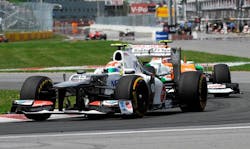The third consecutive street circuit on this year’s Formula One calendar, the Grand Prix of Europe, contains the highest number of corners of any track all year (25) and is likely to be run in high temperatures – meaning that the P Zero White medium tires and P Zero Yellow soft tyres have been nominated.
This combination highlights both the durability and performance of the tires, on a circuit where overtaking is notoriously difficult. Just like Monaco, qualifying will be crucial, and the speed of the soft tyre will be vital when it comes to boosting drivers up the start order. In the race, the strength and consistency of the medium tyre will form an essential part of the strategy.
Many of the corners are fast and flow into each other, making overtaking difficult as there is little room for manoeuvre and not a huge speed differential between the cars. The final sequence of corners is taken in rapid succession at 290kph, followed by a heavy braking area into the last corner where the cars go from 310 to 60kph in less than 130 metres. The deceleration peaks at 5.2g, with a big risk of locking up a wheel, but the layout of the corner means that it is still not easy to pass the car in front. This will put the emphasis on strategy, as cars try to get past each other in the pits as well as on the track.
Last year, the frontrunners all adopted the same strategy: starting on the soft tyre and stopping three times before completing a final stint on the medium tyre. With the cars more closely matched than ever, the right tactics will be even more important this time.
Like all street circuits, the track evolution over the course of the weekend will be notable as more and more rubber is laid down.
Pirelli’s motorsport director says:
Paul Hembery: “Valencia could not present a bigger contrast to the street circuits that have come before it: the track is faster and the temperatures higher, with plenty of energy going through the tyres. What it has in common with the others is the difficulty of overtaking, which will put the emphasis on qualifying. So we are expecting a fairly straightforward race, with either two or three stops depending on which tactics the teams use – although one team tried a one-stopper last year as well. The weather should be consistently warm throughout the weekend, which should lead to fewer variables in terms of temperature, so there probably won’t be many big surprises to emerge. We’ve used the combination of soft and medium tires more than any other line-up so far this year, as it has shown itself to be a perfect compromise between performance and durability, allowing drivers to show their speed when they need to but also benefit from longer stints in the race.”
The men behind the steering wheel say:
Pastor Maldonado (Williams F1 Team): “Valencia is not a typical circuit because it is a mixture between a normal race track and regular roads that are used throughout the year, so it is always tricky to put every element together. The track also tends to evolve a lot from session to session which can throw up some surprises. It has quite long straights and a number of slow speed corners, which makes it difficult to find a good balance with the car. The air and track temperatures tend to be high and it is a long race, so it is a challenging circuit for tires, with good tyre management important if you want to get a strong result. It is also useful to conserve your tires ahead of the race because if you have an extra set you will have an advantage.”
Technical tyre notes:
• The brakes work hard at Valencia, with several big stops from more than 300kph. This is a challenging task for the front tires in particular, which have to slow the car down and turn in at the same time – subjecting themselves to two different forces. Traction rather than braking constitutes the biggest longitudinal force in Valencia though.
• One of the key factors to a good set-up in Valencia, with 25 corners, is ensuring that the cars turn in precisely. A stiffer suspension set-up would be ideal for this, but at the same time the suspension has to be soft enough to ensure a good level of mechanical grip in the slow corners as well. As usual, it’s a delicate compromise.
• The surface in Valencia is not especially abrasive: in fact it is very slippery at the start of the weekend. However, the constant traction demands also mean that the rear tires are worked hard and teams will need to keep an eye on the wear in this area.



